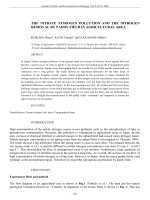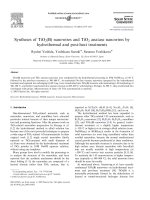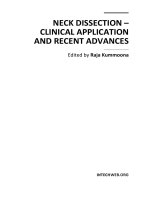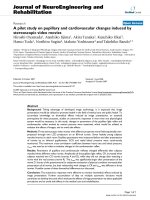Species and Varieties, Their Origin by Mutation, by Hugo DeVries docx
Bạn đang xem bản rút gọn của tài liệu. Xem và tải ngay bản đầy đủ của tài liệu tại đây (2.83 MB, 1,606 trang )
The Project Gutenberg EBook of Species
and Varieties, Their Origin by Mutation,
by Hugo DeVries
Copyright laws are changing all over the
world. Be sure to check the copyright
laws for your country before downloading
or redistributing this or any other Project
Gutenberg eBook.
This header should be the first thing seen
when viewing this Project Gutenberg file.
Please do not remove it. Do not change or
edit the header without written
permission.
Please read the "legal small print," and
other information about the eBook and
Project Gutenberg at the bottom of this
file. Included is important information
about your specific rights and restrictions
in how the file may be used. You can also
find out about how to make a donation to
Project Gutenberg, and how to get
involved.
**Welcome To The World of Free Plain
Vanilla Electronic Texts**
**eBooks Readable By Both Humans and
By Computers, Since 1971**
*****These eBooks Were Prepared By
Thousands of Volunteers!*****
Title: Species and Varieties, Their Origin
by Mutation
Author: Hugo DeVries
Release Date: January, 2005 [EBook
#7234] [Yes, we are more than one year
ahead of schedule] [This file was first
posted on March 30, 2003]
Edition: 10
Language: English
*** START OF THE PROJECT
GUTENBERG EBOOK SPECIES AND
VARIETIES ***
Produced by Dave Gowan
<>
Species and Varieties
Their Origin by Mutation
Lectures delivered at the University of
California
By
Hugo DeVries
Professor of Botany in the University of
Amsterdam
Edited by
Daniel Trembly MacDougal
Director Department of Botanical
Research
Carnegie Institution of Washington
Second Edition
Corrected and Revised
CHICAGO
The Open Court Publishing Company
LONDON
Kegan Paul, Trench, Trubner and Co., Ltd.
1906
- - - - -
COPYRIGHT 1904
BY
The Open Court Pub. Co.
CHICAGO
- - - - -
THE ORIGIN OF SPECIES
The origin of species is a natural
phenomenon.
LAMARCK
The origin of species is an object of
inquiry.
DARWIN
The origin of species is an object of
experimental investigation.
DeVRIES.
- - - - -
PREFACE BY THE AUTHOR
THE purpose of these lectures is to point
out the means and methods by which the
origin of species and varieties may
become an object for experimental
inquiry, in the interest of agricultural and
horticultural practice as well as in that of
general biologic science. Comparative
studies have contributed all the evidence
hitherto adduced for the support of the
Darwinian theory of descent and given us
some general ideas about the main lines of
the pedigree of the vegetable kingdom, but
the way in which one species originates
from another has not been adequately
explained. The current belief assumes that
species are slowly changed into new
types. In contradiction to this conception
the theory of mutation assumes that new
species and varieties are produced from
existing forms by sudden leaps. The
parent-type itself remains unchanged
throughout this process, and may
repeatedly give birth to new forms. These
may arise simultaneously and in groups or
separately at more or less widely distant
periods.
The principal features of the theory of
mutation have been dealt with at length in
my book "Die Mutationstheorie" (Vol. I.,
1901, Vol. II., 1903. Leipsic, Veit & Co.),
in which I have endeavored to present as
completely as possible the detailed
evidence obtained from trustworthy
historical records, and from my own
experimental researches, upon which the
theory is based.
The University of California invited me to
deliver a series of lectures on this subject,
at Berkeley, during the [vii] summer of
1904, and these lectures are offered in this
form to a public now thoroughly interested
in the progress of modern ideas on
evolution. Some of my experiments and
pedigree-cultures are described here in a
manner similar to that used in the
"Mutationstheorie," but partly abridged
and partly elaborated, in order to give a
clear conception of their extent and scope.
New experiments and observations have
been added, and a wider choice of the
material afforded by the more recent
current literature has been made in the
interest of a clear representation of the
leading ideas, leaving the exact and
detailed proofs thereof to the students of
the larger book.
Scientific demonstration is often long and
encumbered with difficult points of minor
importance. In these lectures I have tried
to devote attention to the more important
phases of the subject and have avoided the
details of lesser interest to the general
reader.
Considerable care has been bestowed
upon the indication of the lacunae in our
knowledge of the subject and the methods
by which they may be filled. Many
interesting observations bearing upon the
little known parts of the subject may be
made with limited facilities, either in the
garden or upon the wild flora. Accuracy
and perseverance, and a warm love for
Nature's children are here the chief
requirements in such investigations.
In his admirable treatise on Evolution and
Adaptation (New York, Macmillan & Co.,
1903), Thomas Hunt Morgan has dealt in a
critical manner with many of the
speculations upon problems subsidiary to
the theory of descent, in so convincing and
complete a manner, that I think myself
justified in neglecting these questions
here. His book gives an accurate survey of
them all, and is easily understood by the
general reader.
In concluding I have to offer my thanks to
Dr. D.T. MacDougal and Miss A.M. Vail
of the New York Botanical Garden for
their painstaking work in the preparation
of the manuscript for the press. Dr.
MacDougal, by [viii] his publications, has
introduced my results to his American
colleagues, and moreover by his cultures
of the mutative species of the great
evening-primrose has contributed
additional proof of the validity of my
views, which will go far to obviate the
difficulties, which are still in the way of a
more universal acceptation of the theory
of mutation. My work claims to be in full
accord with the principles laid down by
Darwin, and to give a thorough and sharp
analysis of some of the ideas of
variability, inheritance, selection, and
mutation, which were necessarily vague at
his time. It is only just to state, that
Darwin established so broad a basis for
scientific research upon these subjects,
that after half a century many problems of
major interest remain to be taken up. The
work now demanding our attention is
manifestly that of the experimental
observation and control of the origin of
species. The principal object of these
lectures is to secure a more general
appreciation of this kind of work.
HUGO DE VRIES.
Amsterdam, October, 1904.
[ix]
PREFACE BY THE EDITOR
PROFESSOR DE VRIES has rendered an
additional service to all naturalists by the
preparation of the lectures on mutation
published in the present volume. A
perusal of the lectures will show that the
subject matter of "Die Mutationstheorie"
has been presented in a somewhat
condensed form, and that the time which
has elapsed since the original was
prepared has given opportunity for the
acquisition of additional facts, and a re-
examination of some of the more important
conclusions with the result that a notable
gain has been made in the treatment of
some complicated problems.
It is hoped that the appearance of this
English version of the theory of mutation
will do much to stimulate investigation of
the various phases of the subject. This
volume, however, is by no means intended
to replace, as a work of reference, the
larger book with its detailed recital of
facts and its comprehensive records, but it
may prove a substitute for the use of the
general reader.
The revision of the lectures has been a
task attended with no little pleasure,
especially since it has given the editor the
opportunity for an advance consideration
of some of the more recent results, thus
materially facilitating investigations
which have been in progress at the New
York Botanical Garden for some time. So
far as the ground has been covered the
researches in question corroborate the
conclusions of de Vries in all important
particulars. The preparation of the
manuscript for the printer has consisted
chiefly in the adaptation of oral [xii]
discussions and demonstrations to a form
suitable for permanent record, together
with certain other alterations which have
been duly submitted to the author. The
original phraseology has been preserved
as far as possible. The editor wishes to
acknowledge material assistance in this
work from Miss A.M. Vail, Librarian of
the New York Botanical Garden.
D.T. MacDougal.
New York Botanical Garden, October,
1904.
PREFACE TO THE SECOND
EDITION.
THE constantly increasing interest in all
phases of evolution has made necessary
the preparation of a second edition of this
book within a few months after the first
appeared. The opportunity has been used
to eliminate typographical errors, and to
make alterations in the form of a few
sentences for the sake of clearness and
smoothness. The subject matter remains
practically unchanged. An explanatory
note has been added on page 575 in order
to avoid confusion as to the identity of
some of the plants which figure
prominently in the experimental
investigations in Amsterdam and New
York.
The portrait which forms the frontispiece
is a reproduction of a photograph taken by
Professor F.E. Lloyd and Dr. W.A.
Cannon during the visit of Professor de
Vries at the Desert Botanical Laboratory
of the Carnegie Institution, at Tucson,
Arizona, in June, 1904.
D. T. MACDOUGAL.
December 15, 1905.
CONTENTS
A. INTRODUCTION.
LECTURE PAGE
I. Descent: theories of evolution and
methods of investigation. 1 The theory of
descent and of natural selection. Evolution
and adaptation. Elementary species and
varieties. Methods of scientific pedigree-
culture.
B. ELEMENTARY SPECIES.
II. Elementary species in nature. 32 Viola
tricolor, Draba verna, Primula acaulis,
and other examples. Euphorbia
pecacuanha. Prunus maritima.
Taraxacum and Hieracium.
III. Elementary species of cultivated
plants. 63
Beets, apples, pears, clover, flax and
coconut.
IV. Selection of elementary species. 92
Cereals. Le Couteur. Running out of
varieties. Rimpau and
Risler, Avena fatua. Meadows. Old
Egyptian cereals. Selection by the
Romans. Shirreff. Hays.
C. RETROGRADE VARIETIES.
V. Characters of retrograde varieties. 121
Seed varieties of pure, not hybrid origin.
Differences from elementary species.
Latent characters. Ray-florets of
composites. [xiii] Progressive red
varieties. Apparent losses. Xanthium
canadense. Correlative variability.
Laciniate leaves and petals. Compound
characters.
VI. Stability and real atavism. 154
Constancy of retrograde varieties.
Atavism in Ribes sanguineum
Albidum, in conifers, in Iris pallida.
Seedlings of Acacia.
Reversion by buds.
VII. Ordinary or false atavism. 185
Vicinism or variation under the influence
of pollination by neighboring individuals.
Vicinism in nurseries. Purifying new and
old varieties. A case of running out of
corn in Germany.
VIII. Latent characters. 216 Leaves of
seedlings, adventitious buds, systematic
latency and retrogressive evolution.
Degressive evolution. Latency of specific
and varietal characters in wheat-ear
carnation, in the green dahlias, in white
campanulas and others. Systematic latency
of flower colors.
IX. Crossing of species and varieties. 247
Balanced and unbalanced, or species
and variety crosses.
Constant hybrids of Oenothera muricata
and O. biennis. Aegilops,
Medicago, brambles and other instances.
X. Mendel's law of balanced crosses. 276
Pairs of antagonistic characters, one
active and one latent. Papaver
somniferum. [xiv] Mephisto Danebrog.
Mendel's laws. Unit- characters.
D. EVERSPORTING VARIETIES.
XI. Striped flowers. 309 Antirrhinum
majus luteum rubro-striatum with
pedigree. Striped flowers, fruits and
radishes. Double stocks.
XII. "Five leaved" clover. 340 Origin of
this variety. Periodicity of the anomaly.
Pedigree- cultures. Ascidia.
XIII. Polycephalic poppies. 369
Permanency and high variability.
Sensitive period of the anomaly.
Dependency on external conditions.
XIV. Monstrosities. 400 Inheritance of
monstrosities. Half races and middle
races. Hereditary value of atavists.
Twisted stems and fasciations. Middle
races of tricotyls and syncotyls. Selection
by the hereditary percentage among the
offspring.
XV. Double adaptations. 430 Analogy
between double adaptations and
anomalous middle races. Polygonum
amphibium. Alpine plants. Othonna
crassifolia. Leaves in sunshine and
shadow. Giants and dwarfs. Figs and ivy.
Leaves of seedlings.
E. MUTATIONS.
XVI. Origin of the peloric toad-flax. 459
Sudden and frequent origin in the wild
state. Origin in the experiment-garden.
Law of repeated mutations. Probable









